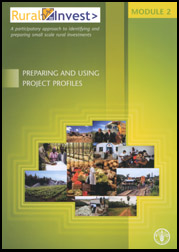|
The designations employed and the presentation of material in
this information product do not imply the expression of any opinion whatsoever
on the part of the Food and Agriculture Organization of the United Nations
concerning the legal or development status of any country, territory, city or
area or of its authorities, or concerning the delimitation of its frontiers or
boundaries.
All rights reserved. Reproduction and dissemination of material in this information
product for educational or other non-commercial purposes are authorized
without any prior written permission from the copyright holders provided
the source is fully acknowledged. Reproduction of material in this information
product for resale or other commercial purposes is prohibited without
written permission of the copyright holders. Applications for such permission
should be addressed to the Director, Investment Centre Division, FAO,
Viale delle Terme di Caracalla, 00100 Rome, Italy or by e-mail to [email protected]
© FAO 2005 |
